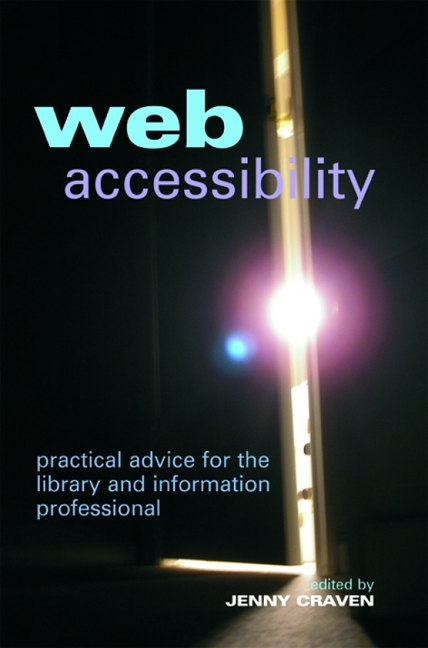Book contents
- Frontmatter
- Contents
- Contributors
- 1 Introduction
- 2 Tools used for widening access to the web
- 3 Design for All – how web accessibility affects different people
- 4 The importance of web accessibility
- 5 Accessibility advice and guidance
- 6 Accessibility evaluation and assessment
- 7 Issues for library and information services
- 8 Design for All in the library and information science curriculum
- 9 Best practice examples of web accessibility
- 10 Web accessibility in the future
- Index
4 - The importance of web accessibility
Published online by Cambridge University Press: 08 June 2018
- Frontmatter
- Contents
- Contributors
- 1 Introduction
- 2 Tools used for widening access to the web
- 3 Design for All – how web accessibility affects different people
- 4 The importance of web accessibility
- 5 Accessibility advice and guidance
- 6 Accessibility evaluation and assessment
- 7 Issues for library and information services
- 8 Design for All in the library and information science curriculum
- 9 Best practice examples of web accessibility
- 10 Web accessibility in the future
- Index
Summary
Introduction
Web accessibility has in recent years emerged from being a niche area of web development of little general interest to become something of a hot topic, discussed by web developers and designers, a subject for academic research and something that is increasingly influential at a policy, contractual and legislative level. Why should this be? There is, of course, a basic moral argument that people should not face undue discrimination as a result of their disability. This social motivation is one of four core arguments presented by the Web Accessibility Initiative (WAI) of the World Wide Web Consortium (W3C) in its drive to promote online accessibility (W3C, 2005). This chapter looks at the motivations and arguments for accessibility.
Social factors
The most fundamental argument for web accessibility is simply that including people with sensory, physical and/or cognitive disabilities enables access to web resources for a wider proportion of the target audience than would otherwise have been reached.
Disabled people are frequently identified as a group experiencing social exclusion because of barriers they face in attempting to perform everyday tasks such as accessing information or communicating; participating in or receiving services such as entertainment, shopping, education and health - care; and democratic processes such as voting in government elections. The barriers encountered by disabled people may include physical obstacles such as stairs in the built environment, or lack of information in a suitable alternative medium for those with visual or hearing impairments. These realworld accessibility barriers may exist to such an extent that the independence of the disabled person is severely restricted, or even lost.
The world wide web, as conceived by its founder Tim Berners-Lee, was intended as an information and communication space in which participation was not affected by personal circumstance, such as a disability. Berners-Lee foresaw the potential of digital information and web services to overcome many of the challenges faced by disabled people in the physical world (see Chapter 5, section on ‘World Wide Web Consortium’).
So, for example, by using the web, the same electronic information and services provided by a website that has been designed with accessibility in mind can be accessed by:
• people who are blind or visually impaired, who can use text-to-speech devices to listen to the content in audio format, or Braille displays to output the content in tactile format
- Type
- Chapter
- Information
- Web AccessibilityPractical Advice for the Library and Information Professional, pp. 41 - 56Publisher: FacetPrint publication year: 2008

